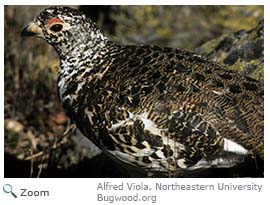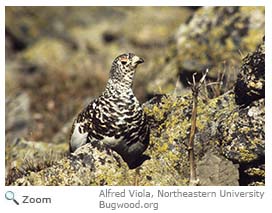Characteristics
 The white-tailed ptarmigan is a small, pear-shaped grouse. It is a foot in length and is the smallest of the ptarmigans and the only ptarmigan with an all white tail. It is a mottled grayish-brown in summer and white in winter. It has white wings and a short, white tail. It has feathers on its legs and it has a small bill. Males and females look alike in winter. In breeding season, the male has a red comb over his eyes.
The female has a less conspicuous comb over her eyes. The white-tailed ptarmigan is a small, pear-shaped grouse. It is a foot in length and is the smallest of the ptarmigans and the only ptarmigan with an all white tail. It is a mottled grayish-brown in summer and white in winter. It has white wings and a short, white tail. It has feathers on its legs and it has a small bill. Males and females look alike in winter. In breeding season, the male has a red comb over his eyes.
The female has a less conspicuous comb over her eyes.
Range
 The white-tailed ptarmigan can be found from southeastern Alaska and Yukon to northern Washington and Montana. It is also found in some parts of the Rocky Mountains in Colorado and New Mexico. It has been introduced to the Sierra Nevada Mountains in California and the Uinta Mountains in Utah. The white-tailed ptarmigan can be found from southeastern Alaska and Yukon to northern Washington and Montana. It is also found in some parts of the Rocky Mountains in Colorado and New Mexico. It has been introduced to the Sierra Nevada Mountains in California and the Uinta Mountains in Utah.
Habitat
The white-tailed ptarmigan lives in alpine meadows and rocky areas at or above the tree line.
|
|
Diet
A large part of the white-tailed ptarmigan's diet is made up of the buds and leaves of willows. It also eats berries, insects, leaves and flowers.
It eats grit to help digest its food.
Life Cycle
 The male white-tailed ptarmigan fans out his tail and struts and bobs to attract a female. He aggressively protects his territory by running low to the ground, flaring out his eye combs and calling out with a harsh cackle. The female lays 2-8 eggs in
scrape on the ground. The eggs incubate for 20-24 days. The chicks leave the nest a few hours after hatching and can feed themselves. The male white-tailed ptarmigan fans out his tail and struts and bobs to attract a female. He aggressively protects his territory by running low to the ground, flaring out his eye combs and calling out with a harsh cackle. The female lays 2-8 eggs in
scrape on the ground. The eggs incubate for 20-24 days. The chicks leave the nest a few hours after hatching and can feed themselves.
Behavior
The white-tailed ptarmigan conserves energy in winter by walking instead of flying. It will also roost in snow banks to stay warm.
|